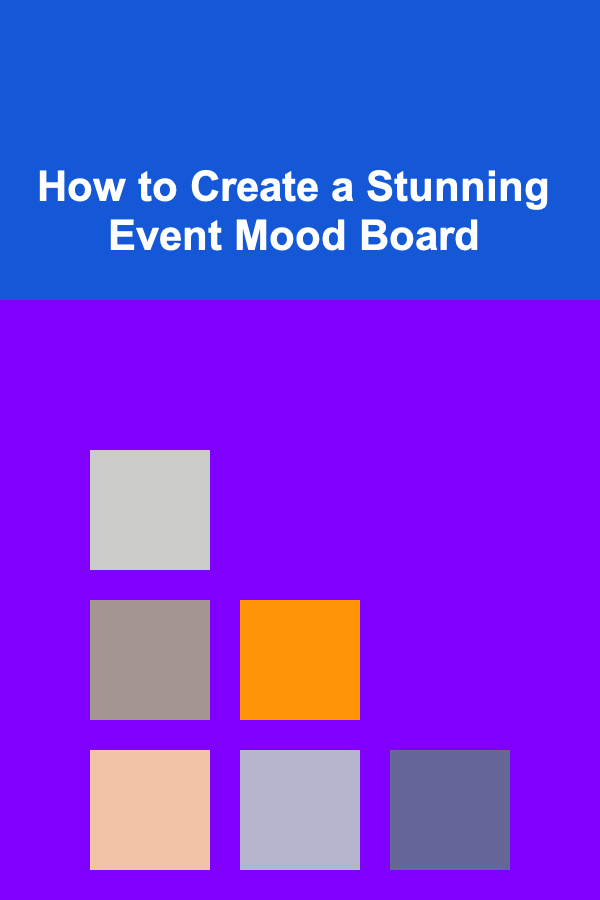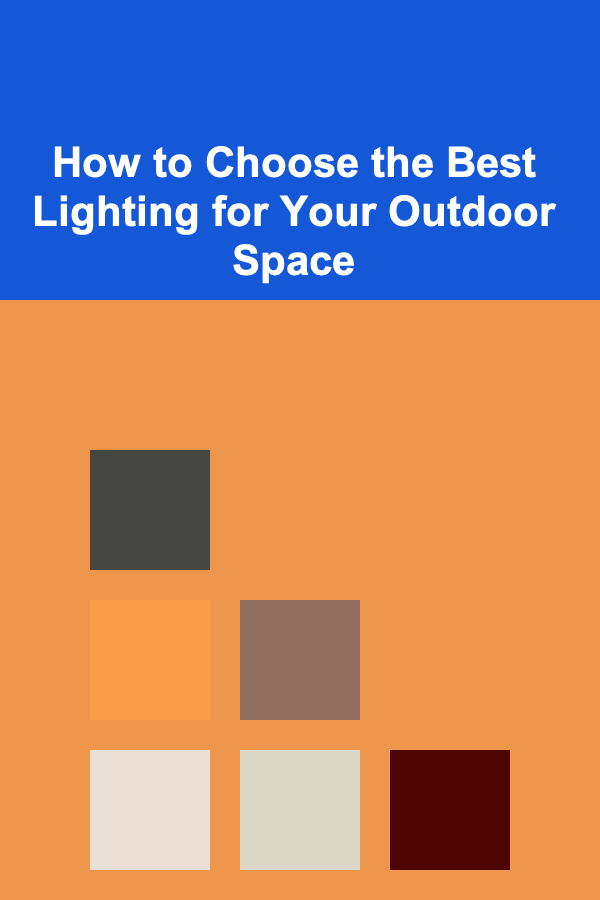
How to Create a Stunning Event Mood Board
ebook include PDF & Audio bundle (Micro Guide)
$12.99$11.99
Limited Time Offer! Order within the next:

Creating an event mood board is one of the first and most important steps in planning an event. It serves as a visual representation of your ideas, theme, and overall aesthetic, helping to align your vision with the rest of the planning team. Whether you're organizing a wedding, a corporate event, a birthday party, or any other type of gathering, a well-crafted mood board can set the tone and provide a clear direction for all the details of the event.
This comprehensive guide will walk you through the process of creating a stunning event mood board, from gathering inspiration to presenting the finished product. We will discuss how mood boards help in event planning, the tools you need, and best practices for creating one that captures the essence of your event.
What is a Mood Board?
A mood board is a collection of images, colors, textures, and design elements that communicate the overall aesthetic or feeling you want to evoke for an event. It serves as a reference point throughout the planning process, ensuring all decisions, from the décor to the invitations, align with your original vision.
Mood boards are not limited to digital or physical images; they can also include fabric swatches, color palettes, typography, and other design elements that inspire you. The goal is to create a cohesive visual representation that helps guide decisions and communicates the vibe of the event to all stakeholders.
Why is a Mood Board Important for Event Planning?
A mood board plays a crucial role in event planning for several reasons:
- Clarifies the Vision: It helps the planner (and all involved parties) clearly understand the vision for the event. This is especially important when there are many people working together on the event, such as vendors, designers, and coordinators.
- Ensures Consistency: By having a central visual reference, you can ensure consistency across every element of the event, from the décor to the invitations to the lighting. It ensures that everything feels cohesive.
- Saves Time and Effort: With a mood board, you can quickly narrow down choices and avoid wasting time on ideas or elements that don't fit with the overall theme.
- Inspires Creativity: As a visual brainstorming tool, a mood board can spark new ideas and encourage creativity. It serves as a foundation for innovation while maintaining focus on the core concept.
Tools You'll Need to Create Your Event Mood Board
Before starting your mood board, you'll need to gather a few tools. There are several ways to create a mood board, from physical collages to digital boards. The choice depends on your personal preference and the tools you feel most comfortable using.
Digital Tools:
- Pinterest: This is an excellent platform for gathering inspiration. You can easily search for ideas, pin them to a board, and organize your thoughts.
- Canva: Canva offers an easy-to-use platform with templates specifically for mood boards. It allows you to create mood boards by dragging and dropping images, adjusting fonts, and experimenting with colors.
- Adobe Spark: Adobe Spark is another tool that lets you create digital mood boards with ease. It provides flexibility in terms of layout, colors, and design elements.
- Milanote: Milanote is a platform tailored for creative professionals, and it provides great features for building visual mood boards with images, videos, and links.
- Google Slides or PowerPoint: You can also create mood boards in presentation software like Google Slides or PowerPoint. Both are simple, easy to use, and allow for the inclusion of a wide range of visual elements.
Physical Tools:
- Poster Boards: If you prefer working with physical materials, a large poster board can be used as the base for your mood board.
- Magazines and Newspapers: Old magazines are great for cutting out images, textures, and color swatches that fit your theme.
- Fabric Swatches: You can include small pieces of fabric to represent the textures you plan to use at the event, such as table linens or upholstery.
- Glue or Tape: For a physical mood board, you'll need adhesive to attach the elements to your poster board.
Steps to Create Your Event Mood Board
Step 1: Define Your Event's Theme and Purpose
Before you start collecting images, it's important to have a clear understanding of the event's theme and purpose. Are you planning a formal gala or a laid-back garden party? Do you want to create a romantic ambiance or something bold and modern?
Ask yourself:
- What is the event's main purpose?
- What type of atmosphere do I want to create (e.g., elegant, rustic, contemporary, vintage)?
- Who is the target audience for the event?
- What is the tone or mood I want to convey?
Step 2: Gather Inspiration
Now that you have an idea of your event's theme, it's time to start gathering inspiration. Here are a few places where you can find visual ideas:
- Online platforms: Pinterest, Instagram, and design blogs are rich sources of inspiration. Use search terms related to your event type (e.g., "wedding inspiration," "corporate event décor," or "birthday party themes").
- Magazines: Browse through magazines for articles on event planning, home décor, and fashion. They often feature curated inspiration for various types of events.
- Nature: Look around at the colors, textures, and patterns in your surroundings. Nature is a great place to find harmonious color palettes and design elements.
- Art and Design: Visit art galleries or browse online galleries for artwork that aligns with your theme. You might be inspired by a painting, photograph, or sculpture.
Step 3: Choose Your Color Palette
The color scheme is one of the most important aspects of an event mood board. Colors have a powerful impact on the overall feeling of the event. For example, warm tones like reds and oranges create a cozy, intimate atmosphere, while cool colors like blues and greens evoke tranquility.
Choose a primary color palette and a few accent colors. Be sure to keep in mind:
- The venue's existing colors (walls, floors, furniture, etc.)
- Seasonal considerations (spring, summer, fall, winter)
- The event's formality (a wedding might use soft pastels, while a corporate event might use more neutral tones)
Step 4: Select Images, Textures, and Materials
Now it's time to start selecting images, textures, and materials that align with your color palette and overall theme. Consider:
- Images of event décor: Think about centerpieces, table settings, floral arrangements, and any other visual elements of the event.
- Textures: These can be represented through fabrics, wallpapers, wood grain, or other materials that convey a certain feeling. For instance, velvet can add luxury, while wood can suggest a rustic vibe.
- Typography: Consider what kind of fonts will be used for invitations, signage, and menus. Bold and modern fonts may work for a contemporary event, while script fonts are great for a romantic or vintage feel.
Step 5: Organize Your Elements
Once you have gathered enough inspiration, it's time to start organizing your visual elements. If you're using a digital tool, create separate sections or columns to divide different parts of your mood board (e.g., one for colors, one for décor ideas, one for textures).
Arrange the images in a way that feels cohesive and harmonious. This step is about trial and error---move things around until it feels just right.
Step 6: Review and Refine
Take a step back and evaluate the mood board. Does it reflect the mood and tone of the event? Is there a clear visual direction, or does it feel scattered? Make sure everything aligns with your vision.
- Remove any elements that don't fit the theme.
- Adjust the placement of images to create balance and flow.
- Ensure the colors and textures complement each other.
Step 7: Present Your Mood Board
Once you're happy with the final result, it's time to present the mood board to your clients, team members, or vendors. If you're working with a team, a digital mood board is especially helpful because it can be easily shared and accessed.
For physical mood boards, take photographs to share with others. Be sure to explain your vision and how each element contributes to the overall concept of the event.
Best Practices for Creating a Mood Board
- Stay Focused: Stick to your theme and color palette. Avoid adding too many elements that might confuse the overall message.
- Be Consistent: Use cohesive design elements across the mood board, including typography, texture, and style.
- Experiment: Don't be afraid to try new ideas, but always be mindful of how they contribute to the overall vision.
- Get Feedback: Share your mood board with trusted colleagues or clients to get feedback and refine your ideas.
Conclusion
Creating a mood board is an essential part of the event planning process. It not only helps clarify your vision but also serves as a tool for ensuring that every decision made during the planning process aligns with the overall theme. Whether you create your mood board digitally or physically, the most important thing is that it accurately reflects the atmosphere and aesthetic you wish to create for your event. By following the steps and best practices outlined in this guide, you'll be well on your way to creating a stunning and impactful mood board for your next event.
Reading More From Our Other Websites
- [Home Security 101] How to Compare the Best Home Security Systems for Seniors: Key Factors to Consider
- [Digital Decluttering Tip 101] The Ultimate Step‑by‑Step Guide to Decluttering and Organizing Your Digital Photo Library
- [Weaving Tip 101] 10 Creative Loom Weaving Projects to Elevate Your Home Décor
- [Home Pet Care 101] How to Set Up a Safe Space for Your Pets at Home
- [Organization Tip 101] How to Create an Inspiration Board for Your Sewing Ideas
- [Personal Finance Management 101] How to Evaluate Free Budget Apps for PC: Pros and Cons
- [Home Budget Decorating 101] How to Create a Cozy Bedroom with Inexpensive Ways to Decorate
- [Star Gazing Tip 101] Celestial Storytelling: Using the Night Sky to Teach and Entertain the Whole Family
- [Organization Tip 101] How to Use Creative Bookmarks for Keeping Track of Reads
- [Organization Tip 101] How to Find the Best Storage Solutions for Small Garages

How to Choose the Best Lighting for Your Outdoor Space
Read More
How to Pack for a Family Vacation: A Detailed Packing Checklist
Read More
Mastering Project Management: Essential Skills for the Modern Project Manager
Read More
How to Use Blockchain for Gaming Economies
Read More
How to Give Feedback That Motivates
Read More10 Tips for Automating Your Home Insurance Expense Tracking
Read MoreOther Products

How to Choose the Best Lighting for Your Outdoor Space
Read More
How to Pack for a Family Vacation: A Detailed Packing Checklist
Read More
Mastering Project Management: Essential Skills for the Modern Project Manager
Read More
How to Use Blockchain for Gaming Economies
Read More